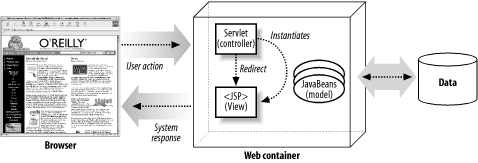1.4 JSP Model 1 and Model 2 Architectures
| The early JSP specifications presented two approaches for building web applications using JSP technology. These two approaches were the JSP Model 1 and Model 2 architectures. Although these terms are no longer used in the JSP specification, they still are widely used throughout the web tier development community. The two JSP architectures differ in several key areas. The major difference is in how and by which component the processing of a request is handled. With the Model 1 architecture, the JSP page handles all of the processing of the request and is responsible for displaying the output to the client. This is illustrated in Figure 1-3. Figure 1-3. JSP Model 1 architecture Notice that there is no servlet involved in the process. The client request is sent directly to a JSP page, which may communicate with JavaBeans or other services, but ultimately the JSP page selects the next page for the client. The next view is determined based on either the JSP selected or parameters within the client's request. In contrast, in the Model 2 architecture, the client request is first intercepted by a servlet, commonly referred to as a controller servlet. This servlet handles the initial processing of the request and determines which JSP page to display next. This approach is illustrated in Figure 1-4. Figure 1-4. JSP Model 2 architecture As shown in the figure, a client never sends a request directly to a JSP page in the Model 2 architecture. This allows the servlet to perform front-end processing, including authentication and authorization, centralized logging, and help with internationalization. Once request processing has completed, the servlet directs the request to the appropriate JSP page. How the next page is determined varies widely across different applications. For example, in simpler applications, the next JSP page to display may be hardcoded in the servlet based on the request, parameters, and current application state. In more sophisticated web applications, a workflow/rules engine might possibly be used. As you can see, the main difference between the two approaches is that the Model 2 architecture introduces a controller servlet that provides a single point of entry and encourages more reuse and extensibility than the Model 1 approach. With the Model 2 architecture, there is a clear separation of the business logic, presentation output, and request processing. This separation is often referred to as a Model-View-Controller (MVC) pattern. One of the key arguments against using the MVC approach is that it seems overly complicated. While at first glance this might appear to be true, using a MVC strategy can actually simplify application design and construction. Web applications built using the Model 2 approach are generally easier to maintain often more extensible than comparable applications built around the Model 1 architecture. |
EAN: 2147483647
Pages: 180